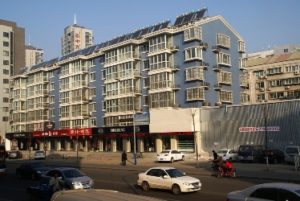Solar-supported 2-pipe Heating Networks in Multi-family Houses (2004)
August 7, 2009
 A challenge for planners: Solar energy is used a lot in multi-storey residential buildings in Austria. The Austrian Institute for Renewable Technologies, AEE Intec, published a handbook of solar-supported heating networks in 2004. Photo: Tisun / Austria Solar
A challenge for planners: Solar energy is used a lot in multi-storey residential buildings in Austria. The Austrian Institute for Renewable Technologies, AEE Intec, published a handbook of solar-supported heating networks in 2004. Photo: Tisun / Austria Solar
Landlords do not seem to automatically think about installing solar thermal applications on the roof of their multi-family houses or building complexes. To reach a shift in thought there, installers or planners need to offer solar solutions that are standardised, efficient and reliable. The 2-pipe heating network – developed in Austria some years ago – was a very important step in this direction.
“We developed a 2-pipe heating network, which includes heating for water, as well as space heating, and where the two pipes minimise the loss of heat,” Christian Fink, engineer at AEE Intec, explains. “The solar heat it produces can be used for space heating or for warm water, depending on the demand of each single apartment unit.”
For many years, the normal supply system for multi-family houses has been a centralised 4-pipe heating network. Central buffer tanks stored the solar-heated water and delivered it separately as hot water and space heating to the single apartment units. This system had the major disadvantage of seasonally-dependent losses between 20% to 100%. The two main advantages of the 4-pipe heating network were its cost-effectiveness and the fact that it needed less space in the apartment. The 2-pipe heating network, however, remains the more convenient solution.
 Concept for solar-supported heat supply: a 2-pipe network that is connected to a decentralised apartment unit. Figure: AEE Intec
Concept for solar-supported heat supply: a 2-pipe network that is connected to a decentralised apartment unit. Figure: AEE Intec
Its hydraulic concept consists of only two pipes. The main difference to the 4-pipe heating network is its decentralised production of warm water within the apartments (see figure above). The new important component of these 2-pipe systems is the so-called “apartment unit”. Its controller unit can decide – depending on the current demand – whether the solar–supported heating network is used for space heating or for the hot water demand of the tenants.
“The domestic hot water is produced by a flow-through principle, which guarantees low return temperatures – if controlled by a correctly adjusted hydraulic,” Fink explains in his paper. These low return temperatures of around 30 °C increase the efficiency of the solar thermal system and simultaneously decrease its pay-back period. But this is only one of the several advantages that a 2-pipe system has:
- The operation costs of the system are very low because of the installed flow-through principle.
- The network also reduces heating losses, as mentioned above.
- It furthermore offers unlimited warm water use for each apartment.
- Hygienic domestic hot water production by flow-through principle.
- The apartment unit’s monitoring system invoices the exact energy use of an apartment unit.
- Installers can integrate the 2-pipe heating network into new or refurbished buildings.
These advantages were so convincing that 2-pipe systems became the standard technology in solar-supported heating networks for multi-family houses in Austria. AEE Intec then published a 120-pages planning handbook about solar-supported heating networks in multi-storey residential buildings. Fink, one of the authors of the handbook, suggested a specific gross collector surface of 0.9 m2 per person for a 12% solar fraction and 1.4 m2 for a 20% solar share in the total heat energy demand of the apartment. You will find more technical advice and details in the attached handbook.
Information on two pipe systems for multi-family houses provided by:
Christian Fink
AEE – Intec
c.fink@aee.at
Text was written by communication expert Hanna Schober based in South Africa. Schober@solrico.com


